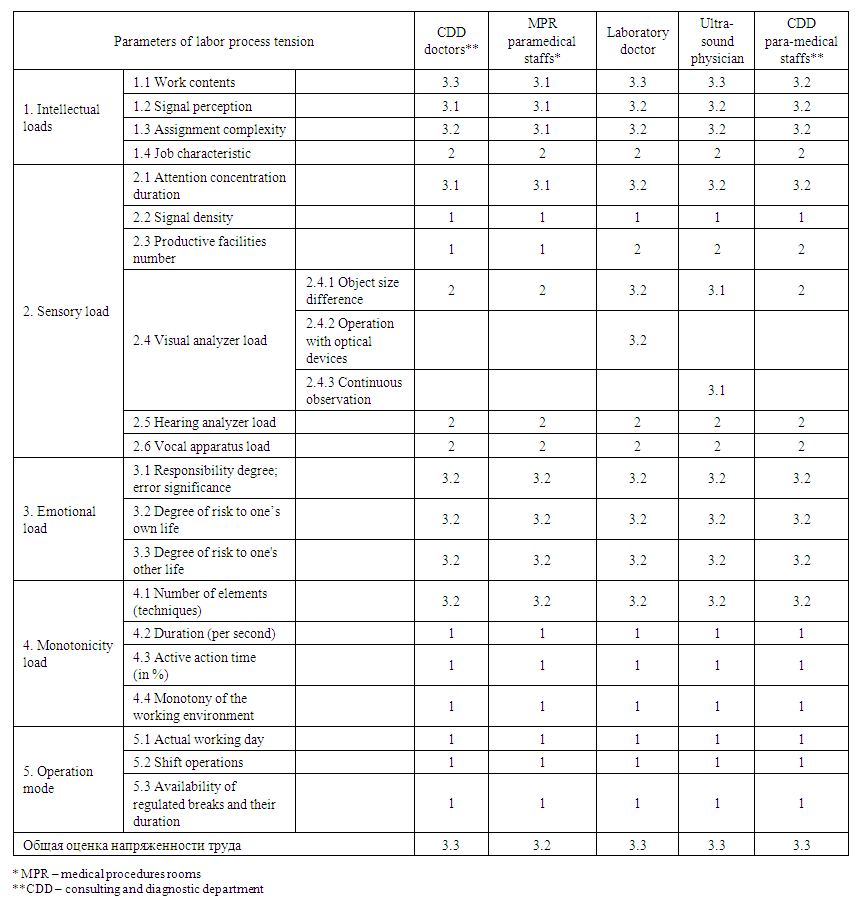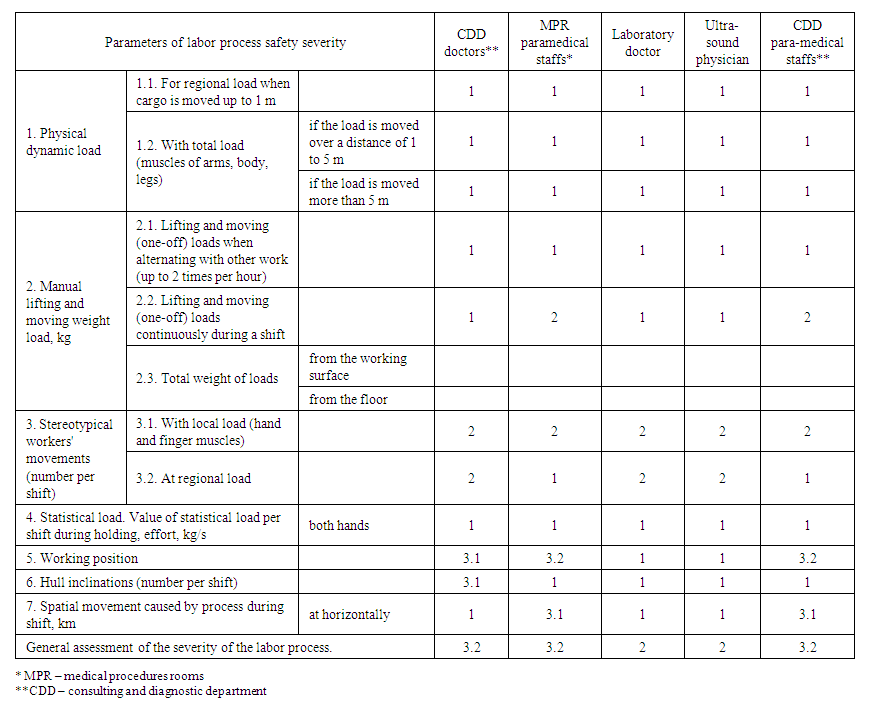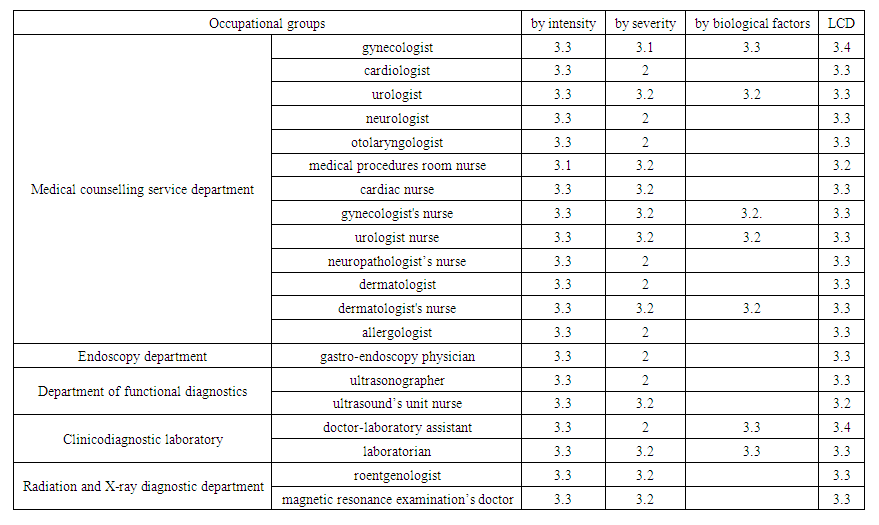-
Paper Information
- Next Paper
- Previous Paper
- Paper Submission
-
Journal Information
- About This Journal
- Editorial Board
- Current Issue
- Archive
- Author Guidelines
- Contact Us
American Journal of Medicine and Medical Sciences
p-ISSN: 2165-901X e-ISSN: 2165-9036
2020; 10(9): 719-724
doi:10.5923/j.ajmms.20201009.19
Received: Aug. 17, 2020; Accepted: Sep. 2, 2020; Published: Sep. 15, 2020

Results of Assessment of Grade and Degree of Harmfulness in Work Condition of Health Workers Indexed According to Difficulty and Intensity of the Working Process
Kamilova R., Ataniyazova R., Ishakova L.
Research Institute of Sanitation, Hygiene and Occupational Diseases, Ministry of Health of the Republic of Uzbekistan
Copyright © 2020 The Author(s). Published by Scientific & Academic Publishing.
This work is licensed under the Creative Commons Attribution International License (CC BY).
http://creativecommons.org/licenses/by/4.0/

The article presents the results of hygiene assessment of working conditions indexed according to grade and degree of harmfulness in work condition of health workers with determining of difficulty and intensity of the working process in medical facilities; The research was carried out in the period from September 2017 to September 2019 by the staff of the RISHOD of the Ministry of Health of Uzbekistan. Working conditions study was performed on 106 health professionals with different functional responsibilities. The study found that the most common disadvantages are the difficulty and intensity of the work process of health workers. The level and degree of work harmfulness for health care staff in each occupational group has been determined, which depends on the employee's occupational group and functional responsibilities.
Keywords: Medical diagnostics Centers, Difficulty and intensity of the working process, Work-related factors, Grade of working conditions
Cite this paper: Kamilova R., Ataniyazova R., Ishakova L., Results of Assessment of Grade and Degree of Harmfulness in Work Condition of Health Workers Indexed According to Difficulty and Intensity of the Working Process, American Journal of Medicine and Medical Sciences, Vol. 10 No. 9, 2020, pp. 719-724. doi: 10.5923/j.ajmms.20201009.19.
- The health and well-being of medical workers determine the quality of medical care provided. Each health-care facility has a complex set of factors that determine occupational risks, among which, depending on the labor process, there are a number of harmful factors, such as those traditionally recognized - biological, chemical, physical, and getting recently the status of occupational - ergonomic, psychological and environmental factors are noted. The conformity of the parameters of the working environment and the labor process with the current hygienic standards is an indicator of the absence of the effect of work-related factors on employees’ health, including their functional state [2,3,4,10].Publications on the hygienic assessment of working conditions and the health of health-care workers were reviewed and it was found that health workers have as high a risk of occupational diseases as industrial workers [2,13].Modern medical service is characterized by advanced technology; the expansion of the list of diagnostic procedures, new equipment and computerization of workplaces, and this creates even more unfavourable factors in the working environment. Under the conditions of the modern development of science and technology, information and innovative technologies, the human body undergoes continuous stressor effects (work-related, psychoemotional, etc.), which must be considered as a complex dynamic system, which continuously adjusts to environmental conditions by changing the level of operation of individual systems and corresponding voltage of the regulatory mechanisms [1,5,6,8,12,16].At the same time, the adaptive capacity of the organism is a reserve of functional reserves which are constantly spent on maintaining the balance between the organism and the external environment. The transition from health state to sickness or from a norm to pathology is a gradual process where overburdening of regulatory systems can lead to exhaustion of the body’s protective forces, reducing its functional capacity [6,8,16].The study found that, in support of numerous studies [1,3,8,9], health-care employees is characterized by intellectual, sensory and emotional pressures. As it is known, the intensity of the labor process is assessed basis on five main parameters: intellectual, sensory and emotional pressures, as well as monotonous loads and operation labor mode [10,11].Studies in the last few years on the state of medical workers' health indicates a high rate of morbidity. Hygienic assessment of production factors and the state of health of employees of laboratory and diagnostic (paraclinic) departments indicates that their work has a destructive impact on both psychological and physical well-being of medical workers [2,3,7,13,14]. High incidence of hypertension, coronary heart disease, musculoskeletal and gastrointestinal diseases is being registered more and more often. The significance of the problems connected to morbidity with temporary disability due to diseases of the respiratory system, digestive organs and diseases of the musculoskeletal system, as well as diseases of the genitourinary system and injuries [5,12,15].Rather often, medical personnel show signs of mental burnout syndrome, which represents the greatest risk to doctors' health. This can manifest itself in a decrease in positive attitudes towards themselves and their surroundings, as well as a loss of work competence.). The consequences are wide and severe, affecting mental and physical health, quality of life and the effectiveness of doctors [13,14,17]. It has been determined that the highest morbidity rates are among doctors in the diagnostic and therapeutic departments and, based on officially confirmed diagnoses, chronic polyethysiological diseases are prevalent among health workers, in which working conditions are of high importance [13,14]. Therefore, the analysis of publications devoted to the researches of working conditions of doctors and their health has allowed to establish that work in medical institutions makes considerable demands to a worker's organism, his physical condition and endurance, volume of operative and long-term memory, ability to resist harmful professional factors. Therefore, the issues of strengthening and preserving the health of workers in a medical facilities are becoming particularly important.The purpose of our research was to study the specifics of the working conditions of medical workers at diagnostic centers in order to identify the level of difficulty and intensity of the working process to further develop of measures to prevent morbidity among health workers.
1. Research Material and Methods
- Hygienic assessment of labor conditions of health workers in 10 medical diagnostic centers located in 4 regions of Uzbekistan: Autonomy Republic of Karakalpakstan Tashkent city, Bukhara and Kashkadarya regions were conducted. The grade of labor conditions were determined by specific work-related factors and general grade by a set of indicators of work-related hazards according to Sanitary Regulations, Norms and Hygienic Standards of the Republic of Uzbekistan (SanPiN RUz) № 0141-03 «Hygienic classification of labor conditions by indicators of harmful and dangerous factors of the work-related environment, difficulty and intensity of the labor process» [8].Statistical data processing was carried out by using a package of programs Statgrphics Plus for Windows-2010 and Microsoft Excel-2013.
2. Results and Their Discussion
- The condition of 106 workplaces has been characterized, 71.7% of which were intended for consulting and diagnostic (CDD) doctors workplaces and for laboratory departments (LD), so 28.3% - for paramedical staffs of the medical procedures rooms (MPR), consulting and diagnostic and laboratory departments in order to carry out a hygienic assessment of labour conditions of medical employees of the Medical Diagnostic Centers. As is known, labor intensity process is assessed according to the main five parameters: intellectual, sensory and emotional pressures, monotony and operation labor mode. In support of numerous studies [1,3,8], we have found that the labor of medical employees is characterized by intellectual, sensory and emotional load.The study results presented in Table 1 make it possible to assert that, depending on activity peculiarities of the studied occupational groups, intensity intellectual parameters of the labor process were established in range from the 2nd to the 3rd grade of the third harmfulness degree. In the analysis of labor intensity parameters of medical employees, it should be noted that the doctors of the consulting medical care department and ultrasound diagnostic rooms, as well as laboratory doctors have been the highest intellectual load of labor conditions were characterized by the 3rd grade of the third harmfulness degree. It is known that the 3rd grade of labor conditions, which has four hazards (3.1, 3.2, 3.3 and 3.4) are characterized by the presence of harmful factors which levels exceed the hygienic standards and have an adverse effect on the workers organizm. This, in turn, contributes to occupational pathology development in mild illness and medium severity, as well as to chronic somatic pathology growth, including an increase in morbidity with temporary incapacity for labor [9,10,11].
 | Table 1. Grades of working conditions of medical professionals of Medical Diagnostics Centers by intensity of the working process |
 | Table 2. Grades of working conditions of medical professionals of Medical Diagnostics Centers by difficulty of the working process |
 | Table 3. Gradees of labor conditions of medical employees of Medical Diagnostics Centers of Various occupations by labor operation process factors |
3. Conclusions
- The labor conditions of medical workers of the Medical Diagnostic Centers have different degrees of harmfulness, depending on their position and functional responsibilities. It has been established that labor conditions of 10% of the studied occupations are classified as 3rd grade of the fourth harmfulness degree (doctor-laboratory assistant, gynecologists), 80% occupations as 3rd grade of the third harmfulness degree and 10% occupations as 3rd grade of the second harmfulness degree (medical procedures room nurse and ultrasound’s unit nurse).The third class of working conditions is assessed as difficult and intense, which contributes to the development of occupational pathology in light and medium forms, as well as to the growth of chronic somatic pathology, including increased morbidity of workers with temporary disability. And there is a requirement to develop of a package of preventive measures to prevent morbidity among health workers.
 Abstract
Abstract Reference
Reference Full-Text PDF
Full-Text PDF Full-text HTML
Full-text HTML